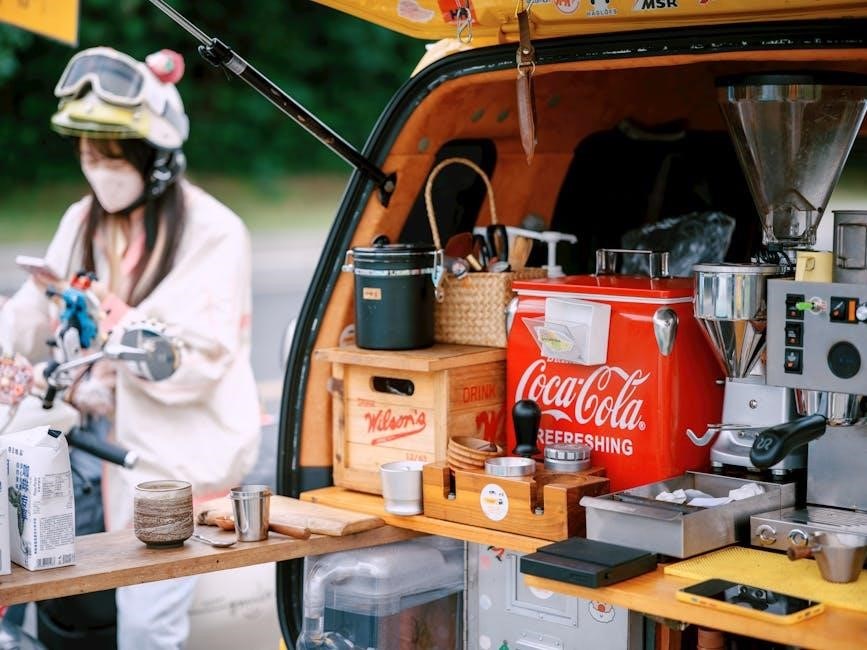Baristas are skilled artisans combining creativity and technical expertise to craft exceptional coffee experiences. From mastering espresso to understanding customer preferences, their role is central to the coffee culture.
What It Means to Be a Barista
Being a barista is more than just serving coffee; it’s a blend of artistry, technical skill, and customer connection. A barista must master milk texturing, latte art, and espresso preparation, requiring patience and practice. Beyond technical skills, a barista’s role involves understanding customer preferences, personalizing drinks, and creating a welcoming atmosphere. Physical stamina is essential, as the job demands standing for long hours and handling repetitive tasks. Attention to detail, from extraction times to cleanliness, ensures high-quality drinks. A friendly demeanor and ability to remember regulars’ orders foster loyalty and satisfaction. Ultimately, a barista is a storyteller, crafting each cup to reflect passion and dedication to their craft.
The Importance of a Barista in the Coffee Industry
A barista is the bridge between coffee beans and the customer, playing a pivotal role in shaping the coffee experience. Their expertise in crafting high-quality drinks directly impacts customer satisfaction and loyalty. Beyond technical skills, baristas are ambassadors of coffee culture, educating customers about flavors and brewing methods. Their ability to personalize drinks and remember preferences fosters a sense of community, making them indispensable to cafes. Additionally, baristas ensure consistency and quality, maintaining the reputation of coffee shops. Their role extends beyond drink preparation, as they handle equipment maintenance and hygiene standards. In essence, baristas are the heartbeat of the coffee industry, elevating it from a daily ritual to an art form.

Essential Skills for Every Barista
Mastering espresso preparation, milk texturing, and extraction times are fundamental. Proficiency in latte art and maintaining equipment ensures high-quality drinks, while attention to detail enhances customer satisfaction.
Pulling the Perfect Espresso Shot
Pulling the perfect espresso shot requires precision and practice. Start by ensuring your machine is preheated and clean. Measure and grind your beans to the ideal fine consistency, then tamp evenly to ensure proper water flow. Place the portafilter in the machine and brew for 20-30 seconds, aiming for a 1-2 ounce yield. The shot should have a thick, creamy crema on top. Pay attention to extraction time and adjust grind size as needed for optimal flavor. Regular backflushing and maintenance of the machine are crucial for consistent results. With practice, you’ll master the balance of flavor and technique to deliver exceptional espresso every time.
Mastering Milk Texturing and Latte Art
Mastering milk texturing and latte art is one of the most challenging yet rewarding skills for baristas. Achieving silky, smooth milk requires precise temperature control and steam wand technique. At home, electric frothers can help, but latte art typically needs a steam wand for better control. Practice is essential to develop muscle memory for consistent results. Step-by-step guides and videos offer helpful tips, but hands-on practice is key. Start with basic heart designs and gradually experiment with more intricate patterns. Patience and dedication are vital, as mastering latte art can take hundreds of attempts. Perfecting this skill not only enhances drink presentation but also elevates the overall customer experience, making it a cornerstone of a barista’s craft.
Understanding Extraction Times and Dialing-In

Understanding extraction times and dialing-in is crucial for delivering high-quality espresso shots. Extraction time refers to the duration water flows through coffee grounds, typically between 20-30 seconds. Proper timing ensures balanced flavor, avoiding under-extraction (sour) or over-extraction (bitter). Dialing-in involves adjusting grind size, tamping, and machine settings to achieve optimal extraction. Modern espresso machines simplify this process, but baristas must still monitor factors like ground dosage and backflushing. Regular practice and attention to detail are essential for mastering these techniques. Consulting with experienced team members can provide valuable insights and tips for refining your skills. This process ensures consistency and elevates the quality of every cup served.

Coffee Beans and Brewing Methods
Coffee beans vary in flavor profiles based on origin and roast levels. Brewing methods like pour-over, French press, and drip brewing offer unique extraction experiences.
Types of Coffee Beans and Their Flavor Profiles
Coffee beans come in two main species: Arabica and Robusta. Arabica, known for its delicate flavor, offers notes of fruit and floral hints, while Robusta has a bolder, earthier taste. Regional variations further diversify flavor profiles, with Ethiopian beans often showcasing bright acidity and fruity undertones, while Brazilian beans tend to be nuttier and smoother. Processing methods, such as washed or natural, also influence the final taste. Understanding these differences allows baristas to select beans that align with desired drink profiles, enhancing the quality and uniqueness of each brew. This knowledge is essential for crafting memorable coffee experiences.
Roast Levels and Their Impact on Flavor
Coffee roast levels significantly influence the flavor profile of beans. Lighter roasts retain more of the coffee’s natural acidity and fruit notes, offering a brighter, more nuanced taste. Medium roasts balance acidity with a hint of sweetness, while darker roasts bring out bold, rich flavors with notes of chocolate or caramel. The roasting process transforms the beans’ inherent characteristics, with darker roasts losing some acidity but gaining body. Baristas must understand how roast levels affect flavor to select the right beans for specific drinks, ensuring optimal taste in espresso, pour-overs, or other brewing methods. This knowledge enhances their ability to craft beverages that satisfy diverse palates and preferences.
Brewing Methods for Non-Espresso Drinks
Non-espresso brewing methods offer diverse ways to enjoy coffee, each with unique flavor profiles. Pour-over brewing allows for precise control over water temperature and flow, highlighting the coffee’s nuanced notes. French press, or cafetière, involves steeping coarse grounds in hot water, resulting in a rich, bold drink with natural oils. Drip brewing is a convenient method for everyday use, producing a balanced cup. Chemex and Aeropress are also popular, combining elements of pour-over and immersion for smooth, clean flavors. Each method requires specific tools and techniques, enabling baristas to cater to various preferences. Understanding these brewing techniques enhances a barista’s ability to craft high-quality, non-espresso beverages that satisfy a wide range of tastes and occasions.

Health and Wellness for Baristas
Baristas often face physical strain from standing and repetitive tasks. Wearing supportive footwear and maintaining proper posture can prevent long-term foot and back issues, ensuring stamina and well-being.
The Importance of Footwear for Baristas
Footwear plays a crucial role in a barista’s daily comfort and long-term health. Standing for extended periods can lead to foot pain and fatigue, especially in fast-paced environments. Wearing supportive, cushioned shoes with good arch support is essential to prevent discomfort and potential foot problems. Many baristas report feeling the negative effects of inadequate footwear, such as sore feet and back strain, after years of wearing unsuitable shoes like Converse or Pumas. Investing in high-quality, ergonomic footwear can significantly improve stamina and overall well-being. Prioritizing foot health ensures baristas can perform their duties effectively and maintain energy throughout their shifts.
Managing Physical Strain and Maintaining Stamina
Baristas often face physical demands due to standing, lifting, and repetitive tasks. To manage strain, proper posture and movement are essential. Regular stretching and taking short breaks can help reduce muscle fatigue. Staying hydrated and maintaining a balanced diet are crucial for sustaining energy levels throughout shifts. Mental health also plays a role; stress management techniques like deep breathing can prevent burnout. Ensuring adequate rest and exercise outside of work helps build stamina. Employers can support baristas by providing ergonomic workspaces and encouraging health-conscious habits. By prioritizing physical and mental well-being, baristas can maintain their performance and longevity in the profession.

Customer Interaction and Service
Remembering regulars and their orders personalizes their experience, fostering loyalty. A friendly personality and attentive service create a welcoming atmosphere, making customers happy to return and engage.
Building Rapport with Regular Customers
Building rapport with regular customers is key to creating a loyal clientele. Remembering their names, orders, and preferences shows attention to detail and care, fostering trust and loyalty. A friendly demeanor and genuine interest in their day can make customers feel valued. Consistency in service and quality ensures they return, while small gestures like offering a favorite drink before they order enhance their experience. Engaging in light conversation or asking about their interests strengthens the connection. Over time, these interactions create a sense of community, making your cafe a welcoming space they look forward to visiting regularly.
Personalizing the Customer Experience
Personalizing the customer experience is a powerful way to create lasting connections and loyalty. By remembering regulars’ names, orders, and preferences, baristas can tailor interactions to make each visit feel special. Offering personalized drink recommendations based on their tastes enhances satisfaction and shows attention to detail. Small gestures, like preparing their usual drink before they order, demonstrate care and efficiency. Additionally, engaging with customers about their preferences or dietary needs ensures they feel heard and valued. This level of personalization not only boosts customer loyalty but also fosters a welcoming atmosphere, making the cafe a go-to destination for tailored coffee experiences.

Career Development for Baristas
Baristas can advance their careers through specialized training, certifications, and workshops. These resources help refine skills, enhance creativity, and prepare for leadership roles in the coffee industry.
Barista Training and Certification Programs
Barista training and certification programs are essential for mastering coffee preparation skills. These programs, often offered by coffee associations or specialized schools, cover foundational techniques like espresso extraction, milk texturing, and latte art. Certifications, such as those from the Specialty Coffee Association (SCA) or the Barista Guild, validate a barista’s expertise and commitment to quality. Many programs also focus on coffee theory, including bean origins, roast levels, and brewing methods. Practical training emphasizes hands-on practice to develop muscle memory and consistency. Additionally, certifications often include modules on customer service and cafe operations, preparing baristas for real-world challenges. These programs are invaluable for both newcomers and experienced baristas looking to refine their craft and advance their careers in the coffee industry.
How to Apply for Barista Jobs
Applying for barista jobs requires a strategic approach to stand out in a competitive market. Start by researching cafes that align with your values and skills. Tailor your resume to highlight relevant experience, such as customer service, teamwork, and any coffee-related skills. Emphasize transferable skills like multitasking and attention to detail. When submitting applications, ensure your resume is concise and professional. Practice for interviews by preparing to discuss your knowledge of coffee, previous work experience, and passion for the industry. Follow up politely after applying to express your interest. Many cafes also value a friendly and personable demeanor, as building rapport with customers is key to the role. Demonstrating enthusiasm and willingness to learn can significantly improve your chances of landing a barista position.
Advanced Techniques for Professional Growth
Mastering advanced techniques elevates a barista’s skills, enhancing both creativity and efficiency. Refining milk texturing and latte art requires precision and practice, allowing for intricate designs that impress customers. Experimenting with unique flavor combinations and signature drinks can set you apart. Continuous learning through workshops and video tutorials helps stay updated on trends. Avoid common mistakes, such as improper extraction times or inconsistent steam pressure, by focusing on attention to detail. Developing muscle memory through repetition ensures smooth service, especially in high-volume environments. Investing time in perfecting these techniques not only boosts confidence but also contributes to professional growth, making you a valuable asset in any coffee shop.
Work Environment and Cafe Operations
A well-equipped cafe with modern espresso machines, grinders, and brewers is essential. Regular maintenance, like backflushing and dialing-in, ensures optimal performance and consistent flavor in every drink.
Essential Equipment for a Coffee Shop
A well-equipped coffee shop requires high-quality machinery to deliver exceptional beverages. The cornerstone is a professional espresso machine, which must be paired with a precise grinder for freshly ground beans. Brewers, such as pour-overs or drip machines, are essential for non-espresso drinks. A reliable milk frother or steam wand is crucial for texturing milk to create lattes and cappuccinos. Additional tools like scales, tampers, and knock boxes ensure consistency and efficiency. Investing in durable equipment not only enhances the quality of drinks but also streamlines workflows, allowing baristas to focus on crafting memorable experiences for customers.
Maintaining Cleanliness and Hygiene Standards
Cleanliness is paramount in a coffee shop to ensure customer safety and satisfaction. Regularly backflushing espresso machines and cleaning steam wands prevents buildup and contamination. Grinders, brewers, and utensils must be sanitized daily to maintain hygiene. Wipe down all surfaces, including countertops and equipment, after each use to prevent cross-contamination. Proper handwashing and glove use are essential when handling food and drinks. A clean environment not only enhances customer trust but also ensures the quality and flavor of beverages. Implementing a daily cleaning routine and training staff on hygiene protocols are vital for upholding high standards and providing a positive experience for patrons.

Seasonal and Specialty Coffee Drinks
Seasonal offerings like pumpkin spice and winter blends captivate coffee lovers, while unique signature drinks showcase creativity and flavor innovation, enhancing the barista’s craft and customer experience.
Popular Seasonal Coffee Offerings
Seasonal coffee drinks captivate customers with unique flavors tied to holidays and weather. Pumpkin spice lattes dominate fall, while peppermint mochas and gingerbread lattes shine during winter. Spring brings floral notes like lavender, and summer highlights refreshing cold brews and fruity iced coffees. These offerings create excitement and variety, allowing baristas to showcase creativity. Incorporating seasonal ingredients, such as cinnamon, nutmeg, or caramel, enhances flavor profiles. Presentation, including festive toppings and designs, adds to the appeal. Understanding these trends helps baristas craft drinks that align with customer cravings, making their cafe a go-to destination for special treats year-round.
Creating Unique Signature Drinks
Crafting unique signature drinks allows baristas to showcase creativity and differentiate their cafe. Start by experimenting with flavor combinations, such as pairing unusual syrups with complementary spices. High-quality ingredients, like small-batch chocolate or rare spices, elevate the drink. Presentation is key—artistic latte designs or vibrant toppings can make the drink Instagram-worthy. Incorporate seasonal ingredients to align with customer preferences. Involve customers in the creation process by offering customizable options. Balancing flavors and textures ensures the drink is both visually appealing and delicious. Signature drinks not only attract loyal customers but also highlight the barista’s skill and passion, making the cafe stand out in a competitive market.
Advanced Barista Techniques
Advanced techniques involve precision, creativity, and efficiency. Mastering intricate latte art, flavor profiling, and troubleshooting common mistakes elevates a barista’s expertise, ensuring exceptional quality and customer satisfaction always.
Common Mistakes to Avoid
One of the most common mistakes baristas make is improper milk texturing, leading to inconsistent foam. Over- or under-extraction of espresso shots can also ruin a drink. Additionally, neglecting to clean equipment regularly can affect flavor and hygiene; Many baristas overlook the importance of using quality beans and water, which are fundamental to a great cup. Another mistake is rushing through orders, which can lead to errors and dissatisfaction. Finally, not paying attention to customer preferences, such as desired temperature or sweetness levels, can hinder the personalization of their experience; Avoiding these pitfalls ensures better quality and customer satisfaction.
Efficiency Tips for High-Volume Cafes
In high-volume cafes, efficiency is key to maintaining quality and customer satisfaction. Organize your workspace to minimize movement, ensuring all tools and ingredients are within easy reach. Pre-measuring ingredients and prepping supplies during slower periods can save valuable time. Streamline your menu to focus on popular drinks, reducing complexity; Multitask by steaming milk while brewing espresso to optimize workflow. Train your team to work in an “assembly line” style, with clear roles to avoid bottlenecks. Regularly clean and maintain equipment to prevent breakdowns. Finally, stay focused and communicate clearly with your team to keep up with demand during peak hours. Efficiency ensures both quality and speed, keeping customers happy and operations smooth.
The barista profession is dynamic, requiring continuous learning and adaptation. Embrace growth, share knowledge, and evolve with industry trends to remain a skilled and passionate coffee artisan.
The Evolution of the Barista Profession
The barista profession has evolved significantly, transitioning from a simple coffee preparer to a skilled artisan. Modern baristas are expected to master advanced techniques, understand flavor profiles, and adapt to trends like seasonal offerings. Continuous learning and certification programs have elevated the profession, emphasizing expertise and creativity. As coffee culture grows, so does the demand for baristas who can innovate and connect with customers. This evolution highlights the importance of staying updated with industry developments and embracing new challenges to remain relevant in a dynamic field.
Continuous Learning and Improvement
Continuous learning is essential for baristas to stay ahead in a dynamic industry. Regular practice and experimentation with techniques, like milk texturing and extraction times, refine skills and adapt to trends. Online resources, such as video tutorials and forums, offer valuable insights and tips. Engaging with communities and attending workshops fosters growth and innovation. Baristas must also stay updated on coffee culture, seasonal offerings, and customer preferences. Investing time in mastering equipment and understanding flavor profiles enhances expertise. Learning is a lifelong process, ensuring baristas remain relevant and capable of delivering exceptional coffee experiences. By embracing continuous improvement, baristas can elevate their craft and contribute to the evolving world of coffee.

Additional Resources
Explore recommended books, online forums, and video tutorials for baristas. These resources offer tips, techniques, and insights to enhance your skills and stay updated on coffee trends.
Recommended Books and Guides
For aspiring and experienced baristas, there are numerous resources available to enhance skills and knowledge. Books like The World Atlas of Coffee by James Hoffmann provide deep insights into coffee science and techniques. Online guides and courses on platforms like Udemy and Coursera offer structured learning paths. Websites such as Barista Hustle and The Sprudge Coffee Guide are excellent for staying updated on trends and tips. Additionally, many coffee shops and professional baristas share tutorials and advice on YouTube and Instagram. These resources cover everything from brewing methods to latte art, ensuring baristas can continuously improve and innovate in their craft.
Online Communities and Forums
Online communities and forums are invaluable resources for baristas to connect, share knowledge, and learn from one another. Platforms like Reddit, with subreddits such as r/barista and r/coffee, offer spaces for discussing techniques, troubleshooting equipment, and exchanging tips. Facebook Groups dedicated to baristas also provide opportunities to network and gain insights from experienced professionals. These forums often feature live streams, Q&A sessions, and shared resources, making them a hub for continuous learning. Whether you’re a novice or an expert, engaging with these communities can enhance your skills and keep you updated on industry trends. They foster collaboration and camaraderie, making them an essential part of a barista’s professional growth journey.
Video Tutorials and Workshops
Video tutorials and workshops are excellent resources for baristas to refine their skills and learn new techniques. Platforms like YouTube offer a wealth of content, from step-by-step guides on crafting popular drinks to advanced methods for latte art and milk texturing. For example, videos by experts like Jimmy demonstrate how to prepare Flatwhite, Latte, and Cappuccino, emphasizing cup type and size. Additionally, tutorials focus on common mistakes, such as improper extraction times, and provide tips for efficiency in high-volume cafes. These visual guides are particularly helpful for hands-on learners, allowing them to observe and replicate techniques in real time. Whether you’re a home barista or a professional, these resources offer invaluable insights and practical advice to elevate your coffee-making skills.

